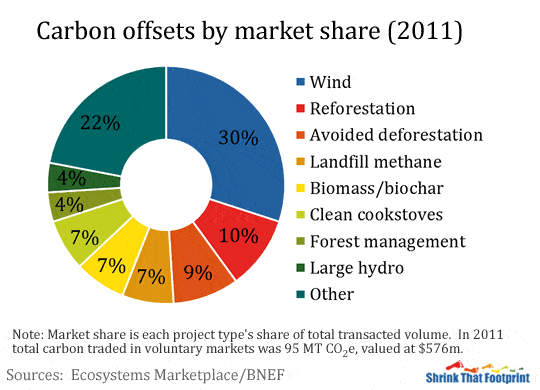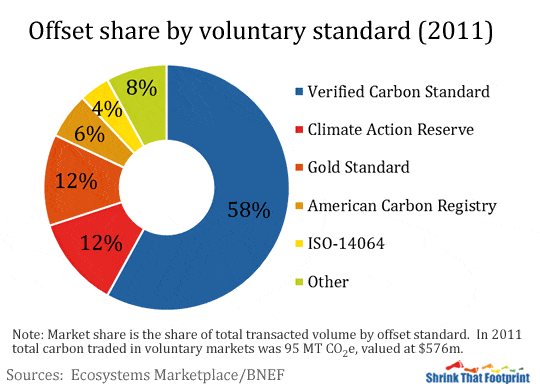Shrinking your own footprint often motivates you to take further climate action. In our working lives, through the political process or by supporting organisations we can sometimes take action that reaches beyond our own footprint. This step will discuss types of further climate action we can take including offsetting emissions, supporting government action and driving business innovation.
Offsetting Emissions
The value of carbon offsetting is a fiercely debated topic. To some they provide a convenient, effective and efficient way for people to reduce emissions, albeit not their own. To others they are an ineffective, poorly regulated and dangerous distraction from the more urgent behaviour needed to tackle climate change. As ever the reality is probably somewhere between the two. Whether or not offsetting is a good idea comes down to two key criteria, the quality of the offset and motivation for its purchase. To be a worthwhile process offsetting must be both high quality and properly motivated.
A good quality offset should meet a number of criteria. The project should produce a real emissions reduction, that reduction should be accurately measured against a baseline, it should be additional (not occur without the project), permanent and independently verified by a third party. After some very rocky beginnings the general quality of carbon offsets is improving with time, due largely to the widespread adoption of voluntary carbon standards and great buyer awareness. Despite these improvements anyone interested in buying offsets should research their offset carefully, and in particular be sure they are happy with additionality of the project they are funding.
Perhaps the most valid criticism of carbon offsetting is that it sends the wrong message, that rather than deal with our own emissions we can simply offset them at a limited cost in a far away place. If your purpose in buying offsets is to avoid making changes that will shrink your own footprint then you fail then your motivations are indeed misplaced. If however you choose to buy high quality offsets as a way of supplementing you actions to shrink your footprint, you motivation could be a positive one.
In fact at their best carbon offsets are nothing to do with offsetting at all. They are the voluntary funding of emissions reductions over and beyond that of a person’s footprint. Not borne out of a sense of guilt but rather as a positive initiative to reduce emissions in an effective and cost efficient manner. In addition to this they can also provide social and environmental co-benefits.
Beyond the important criteria of offset quality and purchaser motivation it is also worth understanding the types of carbon offset exist as well as which voluntary standards are most important. The best way to do so is to analyse the voluntary carbon markets where offsets are traded. In 2012 there were around 95 Mt CO2e of verified emission reduction (VERs) traded globally with a value of $576m. The most common technologies were wind, reforestation/afforestation and avoided deforestation.

Further common technologies included landfill methane, biomass/biochar and clean cookstoves. In terms of voluntary standards the lead ones are the Verified Carbon Standard (VCS), Climate Action Reserve (CAR) and the Gold Standard.

The purpose of these voluntary carbon standards is to insure offsets are well regulated and allow buyers to have confidence in the quality of their offset by knowing that it has met a rigorous third party standard. For buyers of offsets it is ideal to understand the technology, location, timing and standard of the project you are considering in order to assess its merits. For more information about carbon offsetting we recommend the online guide at CORE (Carbon Offset Research & Education).
Alter Your Buying Habits
Saving energy and changing your food habits will go a long way to reducing carbon emissions. Another big one is to alter your buying habits to help the environment in a variety of ways. By reducing your consumption of products, you can reduce the demand for materials used to create those products. This can reduce the amount of resources used to make them and lessen the amount of pollution created in the production process.
Additionally, buying products that are locally produced or made from recycled materials can help reduce the environmental impact of transportation and reduce waste. Being mindful of what you buy and how it affects the environment can go a long way in helping to protect our planet. We have created a guide to buying eco friendly household products that covers the kitchen, bathroom, cleaning etc.
You can also switch to eco-friendly solutions in all parts of your life, for example in the kitchen and in the bathroom. Single use items can be substituted with sustainable materials, and depleted items like hand soap can be switched to sustainable brands or even substituted with natural products like soap nuts. We cover here in more detail how to change your retail behavior and areas that warrant change in this guide on buying eco-friendly products.
Supporting Government Action
Governments around the world have potential to stimulate climate action through their policies. These policies are shaped citizens using their time and votes to push for action on climate change. Governments play a special role in providing incentives for both individuals and businesses to take climate action. In particular they have the capacity to set emissions targets, introduce carbon pricing, mandate energy efficiency standards and support innovation in both science and business. Motivated individuals can play a role in asking for more action by their government. This can be achieved by using your voice, money and time to push for the actions you most agree with.
Emissions targets have been adopted by many countries around the world, but their success in reducing emissions appears to be limited. The most high-profile emissions targets are those adopted in 1997 as part of the Kyoto protocol. These targets which took force in 2005 required 37 industrialized countries to reduce their national production emissions by set amounts. By way of example, the average emissions reduction requirement in the 2008-2012 period was 5.2% below a 1990 baseline. Sadly, the effectiveness such emissions targets has proved sporadic at best.
The reluctance of the US and fast developing countries to sign up to strict emissions targets has made the international negotiation of further targets unworkable to date. In the wake of the failed climate talks in Copenhagen in 2009 many activists have chosen to focus their attention on securing emissions targets within their own country. Such national targets, if combined with a genuine strategy to achieve them, can allow individual countries to forge ahead with their own emission reductions. Sadly however, emission targets have a habit of proving more aspirational than functional.
Carbon pricing has the potential to significantly reduce greenhouse gas emissions by internalising their cost in the prices of products and services we consume. Although the choice between a ‘cap and trade system’ or ‘carbon tax’ is hotly debated, either can be made to provide significant incentive to consumers if implemented carefully.
In the case of a simple carbon tax a price for carbon could be set a certain value per tonne and ten applied to emission intensive actions, like electricity supply, fuel use and industrial production. The effect of such a tax would be to make carbon intensive activities more expensive, and hence less attractive, thus incentivizing consumers to shift their spending away from the activities. If well integrated with other taxation policies such a tax could be a strong driver to reduce greenhouse gas emissions, while limiting the effect on consumer’s welfare. As an individual government policy carbon pricing has perhaps the most potential. So if you only want to get involved in one campaign, it is worthy of consideration.
Efficiency standards for high energy-consuming products like cars, appliances and heating systems have already made a valuable contributions to reducing emissions globally. Standards for new cars and electrical appliances in particular can reduce the fuel or power required to complete a given task, which in turn reduces the footprint of that action. Joining a campaign to push for wider ranging efficiency standards and incentives can help to continue this work.
Support for science and business innovation is something government can play an active role in. On an economic level this type of government policy makes a lot of sense too. Given the ever-growing demand for low-carbon products and services, so successful innovation will be rewarded both in terms of wealth and job creation. Although the fluid nature of technology means picking winners is difficult, by providing the right support and incentives to innovators governments can help foster technologies that are needed to address climate change.
Driving Business Innovation
While government can provide both support and incentives for innovation, the driving force behind innovation is individuals and the businesses they work for. Regardless of your interests and skills we each have the opportunity to be innovative, coming up with ideas, products and strategies that can drive change. Examples like Donnel Baird and BlocPower show models of innovation and sustainability. While inventive engineers may be best placed to create the low-carbon products of the future, by learning about your own footprint you may be able to help drive action at your workplace too.
If you understand, calculate and shrink your carbon footprint you will be well aware of what the challenges of low-carbon living entail. By focusing on your housing, travel, food, product and service footprint you will quickly understand both the behavior and technology required to reduce your personal emissions. The lessons we learn from our own footprint have the potential to change a far larger footprint, if we are prepared to push for change beyond the walls of our homes.
In any business the key decision makers each have the opportunity to push for climate innovation in their processes, products and services. While the potential for action in business may be limited by its primary function, there is always scope for climate innovation in one are or another.
So whether you are a garage inventor, retail assistant or head a multinational, you could play a part in climate innovation in one form or another. Admittedly we do not all share the same capacity to drive change, but that is not a reason not to try.
Summing Up
In this final section we have summarised climate action we can take beyond shrinking our carbon footprint.
While carbon offsets can provide poor incentives, if they are correctly motivated and of good quality they can be a positive way to affect emissions beyond your own footprint. Individuals can look to support various forms of government action, but time is showing that not all policies are not equally effective. Finally, both individuals and their companies can help to drive climate innovation, whether that be in terms of products, services or business practices.
A final summary of this guide follows in the conclusion.
Lindsay Wilson
I founded Shrink That Footprint in November 2012, after a long period of research. For many years I have calculated, studied and worked with carbon footprints, and Shrink That Footprint is that interest come to life.
I have an Economics degree from UCL, have previously worked as an energy efficiency analyst at BNEF and continue to work as a strategy consultant at Maneas. I have consulted to numerous clients in energy and finance, as well as the World Economic Forum.
When I’m not crunching carbon footprints you’ll often find me helping my two year old son tend to the tomatoes, salad and peppers growing in our upcycled greenhouse.
